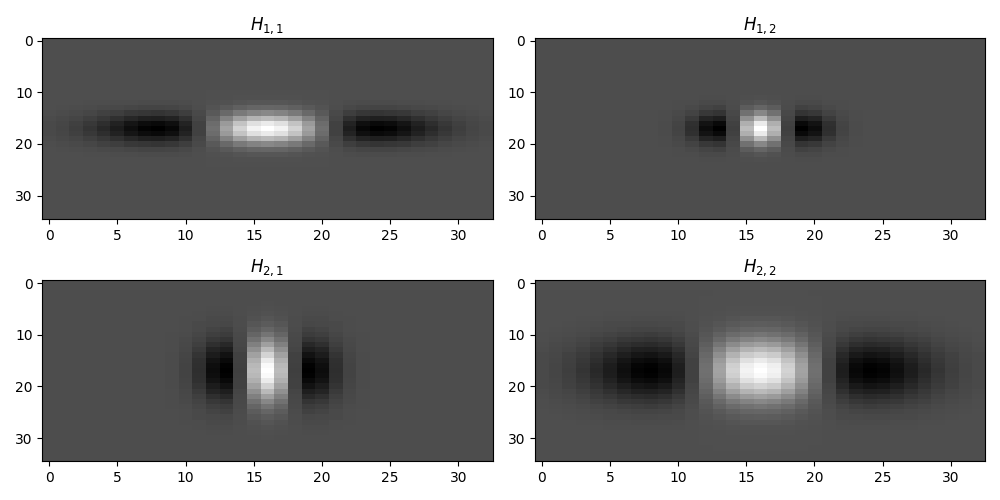Note
Go to the end to download the full example code
Non-stationary Convolution#
This example shows how to use the pylops.signalprocessing.NonStationaryConvolve1D
and pylops.signalprocessing.NonStationaryConvolve2D operators to perform non-stationary
convolution between two signals.
Similar to their stationary counterparts, these operators can be used in the forward model of several common application in signal processing that require filtering of an input signal for a time- or space-varying instrument response.
We will start by creating a zero signal of length nt and we will place a comb of unitary spikes. We also create a non-stationary filter defined by 5 equally spaced Ricker wavelets with dominant frequencies of \(f = 10, 15, 20, 25\) and \(30\) Hz.
nt = 601
dt = 0.004
t = np.arange(nt) * dt
tw = ricker(t[:51], f0=5)[1]
fs = [10, 15, 20, 25, 30]
wavs = np.stack([ricker(t[:51], f0=f)[0] for f in fs])
Cop = pylops.signalprocessing.NonStationaryConvolve1D(
dims=nt, hs=wavs, ih=(101, 201, 301, 401, 501)
)
x = np.zeros(nt)
x[64 : nt - 64 : 64] = 1.0
y = Cop @ x
plt.figure(figsize=(10, 3))
plt.plot(t, x, "k")
plt.plot(t, y, "k")
plt.xlabel("Time [sec]")
plt.title("Input and output")
plt.xlim(0, t[-1])
plt.tight_layout()

Let’s now visualize the filters in time and frequency domain
plt.figure(figsize=(10, 3))
plt.pcolormesh(t, tw, Cop.hsinterp.T, cmap="gray")
plt.xlabel("Time [sec]")
plt.ylabel("Wavelet Time [sec]")
plt.title("Wavelets")
plt.xlim(0, t[-1])
plt.tight_layout()
# Spectra
f = np.fft.rfftfreq(nt, dt)
Sh = np.abs(np.fft.rfft(Cop.hsinterp.T, n=nt, axis=0))
plt.figure(figsize=(10, 3))
plt.pcolormesh(t, f, Sh, cmap="jet", vmax=5e0)
plt.ylabel("Frequency [Hz]")
plt.xlabel("Time [sec]")
plt.title("Wavelet spectrogram")
plt.ylim(0, 70)
plt.xlim(0, t[-1])
plt.tight_layout()
Finally, we repeat the same exercise with a 2-dimensional non-stationary filter
nx, nz = 601, 501
wav1a, _, _ = ricker(t[:17], f0=12)
wav1b, _, _ = ricker(t[:17], f0=30)
wav2a = gaussian(35, 2.0)
wav2b = gaussian(35, 4.0)
wav11 = np.outer(wav1a, wav2a[np.newaxis]).T
wav12 = np.outer(wav1b, wav2a[np.newaxis]).T
wav21 = np.outer(wav1b, wav2b[np.newaxis]).T
wav22 = np.outer(wav1a, wav2b[np.newaxis]).T
wavsize = wav11.shape
hs = np.zeros((2, 2, *wavsize))
hs[0, 0] = wav11
hs[0, 1] = wav12
hs[1, 0] = wav21
hs[1, 1] = wav22
fig, axs = plt.subplots(2, 2, figsize=(10, 5))
axs[0, 0].imshow(wav11, cmap="gray")
axs[0, 0].axis("tight")
axs[0, 0].set_title(r"$H_{1,1}$")
axs[0, 1].imshow(wav12, cmap="gray")
axs[0, 1].axis("tight")
axs[0, 1].set_title(r"$H_{1,2}$")
axs[1, 0].imshow(wav21, cmap="gray")
axs[1, 0].axis("tight")
axs[1, 0].set_title(r"$H_{2,1}$")
axs[1, 1].imshow(wav22, cmap="gray")
axs[1, 1].axis("tight")
axs[1, 1].set_title(r"$H_{2,2}$")
plt.tight_layout()
Cop = pylops.signalprocessing.NonStationaryConvolve2D(
hs=hs, ihx=(201, 401), ihz=(201, 401), dims=(nx, nz), engine="numba"
)
x = np.zeros((nx, nz))
line1 = (np.arange(nx) * np.tan(np.deg2rad(25))).astype(int) + (nz - 1) // 4
line2 = (np.arange(nx) * np.tan(np.deg2rad(-25))).astype(int) + (3 * (nz - 1)) // 4
x[np.arange(nx), np.clip(line1, 0, nz - 1)] = 1.0
x[np.arange(nx), np.clip(line2, 0, nz - 1)] = -1.0
y = Cop @ x
fig, axs = plt.subplots(1, 2, figsize=(10, 4))
axs[0].imshow(x.T, cmap="gray", vmin=-1.0, vmax=1.0)
axs[0].axis("tight")
axs[0].set_title("Input")
axs[1].imshow(y.T, cmap="gray", vmin=-3.0, vmax=3.0)
axs[1].axis("tight")
axs[1].set_title("Output")
plt.tight_layout()
Total running time of the script: (0 minutes 7.291 seconds)




